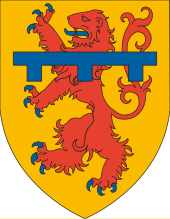Walram I. (Zweibrücken)

Walram I of Zweibrücken († December 1308 ) was Count of the County of Zweibrücken . He ruled from 1281 to 1308. After him, the following Zweibrücken counts are called the dynasty of the Walramids . Until 1297, Walram ran the affairs of government jointly with his brother Eberhard.
family
Walram was the third son of Heinrich II and his wife Agnes von Eberstein . He was married to Agnes von Vaudemont , who died before 1302. Walram himself passed away in December 1308. The couple had three children:
- Simon , the oldest descendant who succeeded Walram as Count von Zweibrücken, † 1311/1312, ∞ Agnes von Saarbrücken
- Heinrich, provost of Hornbach and archdeacon of Strasbourg , † before 1302. A tombstone shared with his mother Agnes is still preserved in the Wörschweiler monastery .
- Daughter unknown by name, nun in Rosenthal
Life
Shortly before the death of Heinrich II, his sons Eberhard and Walram I (also written as Walrab ) took over the affairs of government together. Due to their loyalty to the emperor, they were in the favor of Rudolf von Habsburg , which among other things brought Bergzabern to the city in 1286 and various other benefits: for example, the successor to Count Hartmann von Grüningen as a fiefdom for the Abbey of Klingenmünster in Grüningen and Marbach am Neckar . They continuously expanded their possessions by buying villages and farms. In contrast, the counts made substantial foundations for all the monasteries in their area. After a regional division of responsibilities between the brothers had apparently already taken place in practice, it was decided in 1297 to divide the County of Zweibrücken into two independent lordships. Eberhard, who had previously stayed mainly in Marimont , received the southern areas and thus founded the Zweibrücken-Bitsch line , while the younger brother Walram stayed in Zweibrücken. To distinguish it, he added a blue bridge to his coat of arms, as the Zweibrücken city coat of arms still looks like today.
In the battle of Göllheim , which was fought in 1298 on the soil of the Stauf rulership, which was then part of Zweibrücken , both counts stood on the side of the victorious Albrecht of Austria against the rightful King Adolf of Nassau . In the days around the battle, the brothers stayed in the Rosenthal monastery, where their sister Kunigunde worked as abbess. The corpse of King Adolf was brought here and only transferred to the imperial crypt in the Speyer Cathedral in 1309 . At the beginning of the 14th century, Walram continued his extensive donations to the church. Nevertheless, he was excommunicated by the cathedral chapter in Metz - allegedly on behalf of the Pope. This can be explained by his involvement in the Blieskastel succession dispute, where he and his father had steadfastly and successfully fended off the bishop's claims. At the instigation of Abbot Johannes of the Wadgassen Monastery , Pope Clemens initiated a review. The result is not known.
literature
- Hans-Walter Herrmann : The county of Zweibrücken . In: Kurt Hoppstädter, Hans-Walter Herrmann: Geschichtliche Landeskunde des Saarlandes , Volume 2, Saarbrücken 1977, pp. 316–322. ISBN 3-921870-00-3
- Theodor Julius Ney: Walram I. (Count of and zu Zweibrücken) . In: Allgemeine Deutsche Biographie (ADB). Volume 45, Duncker & Humblot, Leipzig 1900, p. 522.
- Carl Pöhlmann: Regesta of the Counts of Zweibrücken from the Zweibrücken line , edited by Anton Doll, Speyer 1962.
Web links
- Walram I. von Zweibrücken: Certificate. In: Heidelberg historical holdings - digital. Heidelberg University Library , October 26, 1292, accessed on November 5, 2017 .
Individual evidence
- ↑ Württ. Urkundenbuch Volume VII., No. 2548, pp. 409-410, WUB online
- ↑ Württ. Urkundenbuch Volume VIII, No. 3014, p. 254 WUB online
| predecessor | Office | successor |
|---|---|---|
| Henry II |
Count of Zweibrücken 1281–1308 |
Simon |
| personal data | |
|---|---|
| SURNAME | Walram I. |
| ALTERNATIVE NAMES | Walram I of Zweibrücken |
| BRIEF DESCRIPTION | Count of Zweibrücken |
| DATE OF BIRTH | 13th Century |
| DATE OF DEATH | December 1308 |